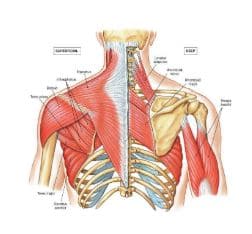Possibly the most effective treatment is exercise therapy focusing on increasing mobility and strength. Gone are the days where rest and a neck collar were prescribed.
Research showed this actually delayed recovery and caused the muscles of the neck to decondition and stiffen.For this blog we will be focusing on strength training for the treatment of neck pain. Now you might be wondering what exercises this involves.
It might surprise you that a lot of the strength exercises which are effective in treating neck pain don’t involve specifically moving the neck.
What exercises will be effective in treating your neck pain will vary depending on the root cause of the problem.
We strongly recommend an appointment with one of our physiotherapists before trying any exercises in order to choose the most suitable option for you.
To first understand the rationale for some of the strengthening exercises, we must first consider the anatomy of the neck and it’s associated musculature.
As you can see in the image below, there are a number of muscles that attach into the neck that originate from the shoulder blade (scapula) and upper thoracic spine.
Examples include the upper trapezius and levator scapula which originate from the shoulder blade.
Because of this cosy relationship between the shoulder, neck and upper back there is a dependency for each region to function optimally in order to produce fluid and pain free movement in joints nearby.

So in the video below you can see an example of an exercise we use for treating painful necks. It’s focussed on strengthening the ‘scapular muscles’ and as you can see there is little movement occurring at the neck.
This is a good example of an exercise we use in the early stages of rehab when neck movement can still be painful for patients.
This helps ensure optimal scapular movement and muscle function which in turn transfers to improved neck movement.
The same types of exercise are also useful for stiff necks. Some people tend to associate strength training with becoming tighter.
During exercise, muscles of course become very tense, and they may feel stiff the next day because of delayed onset muscle soreness (DOMS).
This is what leads some people to believe strength training may make you stiffer.
The (false) idea that strength training makes muscles shorter and less flexible are unfounded. In fact, research shows full range of motion strength training can increase flexibility, perhaps more than stretching.
Exercise also has an analgesic effect and can lower levels of inflammation that cause nervous system sensitivity.
Of course if you overwork your muscles from strength training and don’t let them recover, they will get sensitive, stiff and sore.
But with our guidance in our clinics in Cork or Fermoy, if you work them the right amount – enough to create an adaptation and not too much to prevent full recovery then you will make them healthier, stronger, and yes – less stiff and sore.
If you have any questions or if you would like to talk to one of our Physios, you can call us on (025) 35015 and we would be happy to help.

If you have any other queries or you are not quite sure where to begin, feel free to contact us online here, via email, or over the phone.
You can also avail of a free 15-minute physio consultation in the clinic with one of our physiotherapists.
You can book online at https://apcphysio.ie/speak-with-physio/ Or Give us a call on 02535015 Fermoy Main Office or APC Cork, Club Vitae Clinic calls can be made to 085 7740559 today to talk through any questions and concerns you may have. Thanks for reading!
